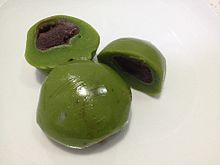Qingtuan
[dummy-text]
Qingtuan
Jump to navigation
Jump to search
| Qingtuan | |||||||||
 Qingtuan, traditional Chinese food of the Qingming festival | |||||||||
| Traditional Chinese | 青團 | ||||||||
|---|---|---|---|---|---|---|---|---|---|
| Simplified Chinese | 青团 | ||||||||
| Literal meaning | verdant lump | ||||||||
| |||||||||
Qīngtuán (青团) is a form of dumpling that is green, common throughout Chinese cuisine. It is made of glutinous rice mixed with Chinese mugwort or barley grass. This is then usually filled with sweet red or black bean paste. The exact technique for making qingtuan is quite complicated and the grass involved is only edible in the early spring, so it is typically only available around the time of the Qingming Festival (April 4 or 5), with which the dumpling has become associated.
Much of the qingtuan consumed in China is prepared and consumed as street food from local vendors.[1]
See also[edit]
Kusa mochi, the Japanese form of this dish, flavored with Jersey cudweed
Caozai guo, the Taiwanese form of this dish, flavored with Jersey cudweed
References[edit]
^ Liu, Zat. "Shanghai food tour: Quest for the best qingtuan". CNN Travel, 31 Mar 2011. Accessed 6 Apr 2014.
External links[edit]
- "青团" in the Baidu Encyclopedia (Baidu Baike) (in Chinese)
- "青团" at Baike.com (in Chinese)
This article related to Chinese cuisine is a stub. You can help Wikipedia by expanding it. |
Categories:
- Chinese cuisine
- Chinese cuisine stubs
(window.RLQ=window.RLQ||).push(function()mw.config.set("wgPageParseReport":"limitreport":"cputime":"0.348","walltime":"0.463","ppvisitednodes":"value":1502,"limit":1000000,"ppgeneratednodes":"value":0,"limit":1500000,"postexpandincludesize":"value":28044,"limit":2097152,"templateargumentsize":"value":1009,"limit":2097152,"expansiondepth":"value":14,"limit":40,"expensivefunctioncount":"value":3,"limit":500,"unstrip-depth":"value":0,"limit":20,"unstrip-size":"value":498,"limit":5000000,"entityaccesscount":"value":0,"limit":400,"timingprofile":["121.90% 506.607 5 Template:Infobox","100.00% 415.600 1 -total"," 73.41% 305.094 1 Template:Infobox_Chinese"," 49.06% 203.875 1 Template:Infobox_Chinese/Chinese"," 38.50% 160.020 2 Template:Lang"," 8.30% 34.494 2 Template:Zh_icon"," 7.68% 31.909 1 Template:Link_language"," 6.65% 27.639 1 Template:Category_handler"," 5.58% 23.190 1 Template:Portal_bar"," 4.55% 18.926 1 Template:Infobox_Chinese/Header"],"scribunto":"limitreport-timeusage":"value":"0.205","limit":"10.000","limitreport-memusage":"value":11294718,"limit":52428800,"cachereport":"origin":"mw1247","timestamp":"20181227124242","ttl":1900800,"transientcontent":false););"@context":"https://schema.org","@type":"Article","name":"Qingtuan","url":"https://en.wikipedia.org/wiki/Qingtuan","sameAs":"http://www.wikidata.org/entity/Q3373858","mainEntity":"http://www.wikidata.org/entity/Q3373858","author":"@type":"Organization","name":"Contributors to Wikimedia projects","publisher":"@type":"Organization","name":"Wikimedia Foundation, Inc.","logo":"@type":"ImageObject","url":"https://www.wikimedia.org/static/images/wmf-hor-googpub.png","datePublished":"2007-02-15T21:24:48Z","dateModified":"2018-03-28T11:23:12Z","image":"https://upload.wikimedia.org/wikipedia/commons/a/a0/Qingtuan_1.jpg"(window.RLQ=window.RLQ||).push(function()mw.config.set("wgBackendResponseTime":110,"wgHostname":"mw1274"););

